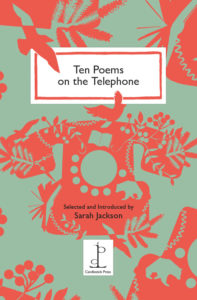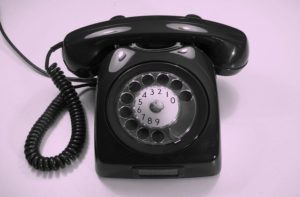Dr Sarah Jackson is currently working on an AHRC-funded creative-critical project that explores the ways the telephone has been conceived by writers and thinkers from the nineteenth-century to the present day. Investigating the different ways that the telephone haunts our reading and writing, it considers and plays out the effects of telephony on literary language and form – from crossed wires and virtual switchboards to the obsolescence of the phone box and the phenomenology of the mobile phone.
Derrida on the Line
Derrida Today, 10.2 (2017), pp. 142-159
But once again, a terrifying telephone […]
Derrida 2007, 242
Yes, yes, this call begins. I can hear you, yes; can you hear me?
Reaching Jacques Derrida on the line requires speaking to the telephone. But this is not simply a matter of picking up the receiver. For the telephone is also, Derrida insists in H.C. for Life, a ‘poetico-technical invention’, that is, the telephone is ‘thought itself’ (Derrida 2006, 100). Therefore, this call is about how the telephone ‘thinks’ Derrida, about how it remembers Derrida, and about how it offers us a line for reimagining his voice. Bound up with the uncanny mechanisms of listening and of writing as calling, I’m talking about the remains of a telephone that continues to ring long after the caller has returned the receiver to its cradle. And in saying this, I call upon you to ‘read with your ears’ (Ronell 1989, xv) and to imagine how speaking to the telephone in Derrida’s work might contribute to opening the lines between different texts, different species and different worlds.
Hello? Are you still there? Can you hear me?
Read MoreTen Poems on the Telephone

Telephone Terrors
BBC Radio 3
The Red Telephone
from Pelt (Northumberland: Bloodaxe, 2012)
The boy stands at the bottom of the stairs clutching an apricot so tightly that the juice runs down between his fingers. In his other hand he holds a red telephone. It is plastic with a curly white cord, and it rings when you pull it along the ground by its string.
The boy pretends to telephone his mother who is upstairs in the bathroom, changing her tights because she has a ladder in her heel. Fall down, he whispers. Fall down. And I swear to you, when her kneecaps crack the bathroom tiles, the small red telephone rings.
Related works by Sarah Jackson:
‘Fiction on the Phone’, Resonance FM
‘Sherlock and the Smartphone’, Huffington Post
Being Human Festival, November 2017
In 1877, The Times reported: ‘A time is coming when everybody, we presume, will carry his own Telephone about with him’. Now, over a century later, there are more telephones in the world than people. For some, the phone is a lifeline; the vital role of mobile connectivity for refugees and migrants, for instance, has been widely documented. But for others, the loss of face-to-face contact, the huge environmental impact, and increasing reports of ‘nomophobia’ (or ‘no-mobile-phone-phobia’ where symptoms include ringing ears and phantom vibrations), mean that – as Mark Twain told telephone engineers in 1877 – ‘if Bell had invented a muffler or a gag, he would have done us a real service’. But despite our increasing preoccupation with the benefits and dangers of the smartphone, our understanding of the aesthetics of telephony remain neglected.

Working with the BT Archives and the Science Museum, my research currently focuses on the ways that the telephone has been conceived by writers from the nineteenth century to the present day. How has the telephone – from Bell’s needle vibrating in water to the iPhone X – changed the ways that we read and write? In particular, I’m interested in the telephone’s capacity to destabilise relations of presence and absence in art and literature; this means thinking about interruption and disconnection as well as communication and contact. What happens, for example, when calls are intercepted or when meaning goes astray? What kinds of voices and what kinds of messages get lost and found down the line? As G. K. Chesterton once remarked, ‘There is only one way of getting through on the telephone: but there are an infinite number of ways of not getting through’.
Reflecting on the telephone in A Lover’s Discourse (1979), the French philosopher Roland Barthes highlights the disruptive capacity of electric speech, suggesting that ‘the telephone is always a cacophony, and that what it transmits is the wrong voice’. Certainly, the power of the telephone to challenge our understanding of what it means to communicate recurs with uncanny frequency in books and films, where calling someone up often means crossing the wires or talking to the dead.

Exploring the different voices that have been lost or found down the line, ‘Switchboard’ was a three-part series of events for Being Human 2017 exploring the cultural legacy of the telephone. ‘Switchboard I‘, the first event in the series, was a workshop at Nottingham Industrial Museum on 19 November 2017 that inspired and supported writers of all levels in the production of new creative work. Building on Nottingham’s own telephonic history, participants had the chance to try their hand on the old exchange, reminisce over the Mickey Mouse character phone, or listen out for ghostly voices down the wires as they developed and shared new writing inspired by the telephone and its many voices.
The second event of the series, ‘Switchboard II‘, took place on 21 November 2017 in a telephone box next to ‘Dialling In’, a phone-booth cafe in Nottingham, reported to be the smallest coffee shop in the United Kingdom. Members of the public were invited to enter the phone box to leave their own messages on our answer-machine, reflecting on the significance of the telephone in their lives or imagining calls yet to be made. Selected extracts from these recordings were used with the authors’ permission during the third event of the series, ‘Switchboard III‘, a live literary event on 23 November 2017 at ‘Wired’ cafe in Nottingham where we celebrated the aesthetics of the phone through poetry and music. For more information, please click the links below.

